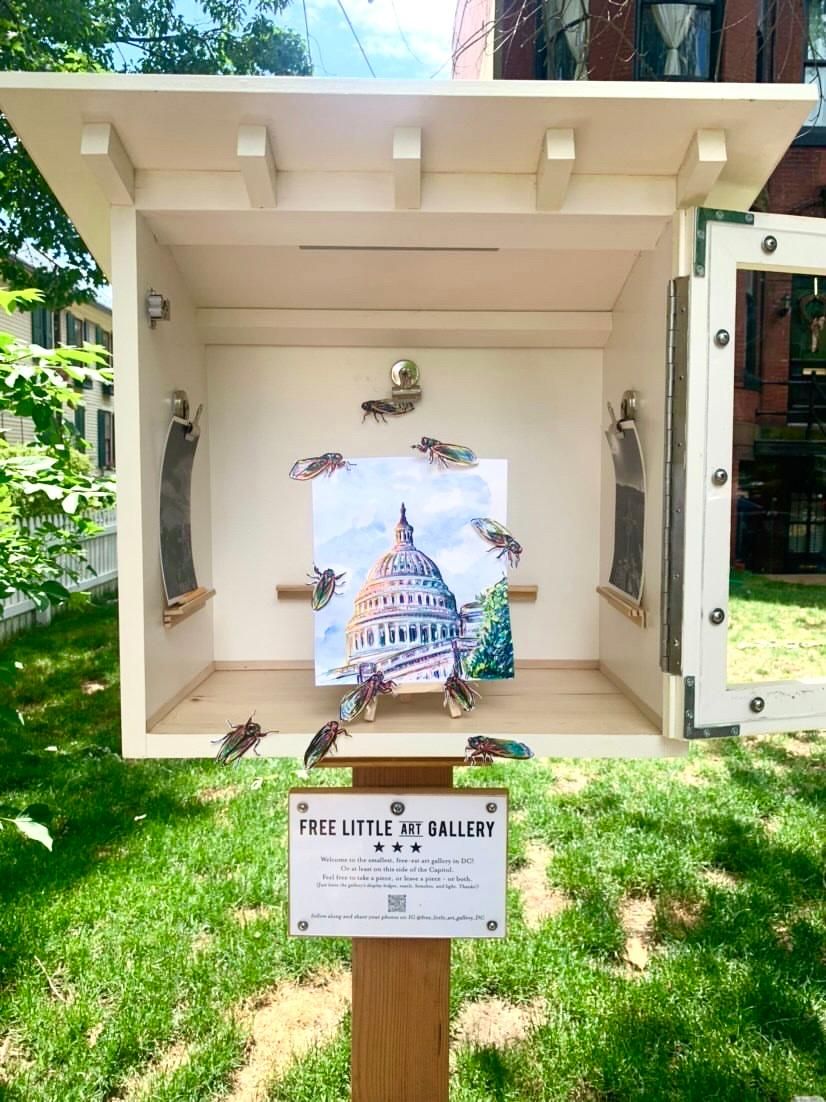Why Free, Miniature Art Galleries Are Popping Up Across the U.S.
Modeled on Little Free Libraries, these pint-sized museums make art accessible during the pandemic
/https://tf-cmsv2-smithsonianmag-media.s3.amazonaws.com/filer/7e/d0/7ed0bffc-1855-418f-846e-d1fe723f2dbe/img_8469.jpg)
For much of the past year, art lovers have found themselves unable to attend new exhibitions or visit their favorite museums. But Covid-19 hasn’t stopped people from sharing art: From Zoom events to drive-by displays, options for socially distanced art appreciation abound.
Among the most innovative offerings are Free Little Art Galleries (FLAGs). As Cathy Free reported for the Washington Post in January, these miniature dioramas are outfitted with small paintings, sculptures and even tiny figures. Inspired by the Little Free Library, which bills itself as the world’s “largest book-sharing movement,” FLAGs encourage visitors to take pint-sized artworks home or leave behind creations of their own.
Washington-based artist Stacy Milrany wasn’t the first person to open a petite art gallery. (Earlier examples appeared in Edmonton, Canada, and Austin, Texas, among other places.) But the trend has gained traction in large part thanks to her Seattle FLAG, which debuted in December 2020. Today, similarly small galleries can be found everywhere from the Bay Area to Atlanta to Washington, D.C.
FLAGs’ popularity stems in part from their intimate setting.
“It’s physically and psychologically accessible,” Milrany tells the Washington Post’s Kelsey Ables. “The art world can get elitist, superficial, alienating, otherwise inaccessible to some people. This is the opposite in every way.”
Milrany traces the idea for her free art gallery to March 2019, when her mother began a four-month chemotherapy regime. Per the artist’s website, she sent a new, postcard-sized artwork to her parent—who lived three hours away—every day of her treatment. Declared cancer-free that October, Milrany’s mother ultimately accumulated about 145 4- by 6-inch pieces “filled with beauty and color [and] containing sentiments of optimism, and sometimes pure ridiculousness.”
Last year, amid the uncertainty of Covid-19 lockdown, Milrany sought to share the solace she’d discovered during her mother’s treatment with a broader audience. As the pandemic persisted, she sent friends and family postcard-sized art, posting the results on her Instagram account. Her followers soon expressed interest in owning similar pieces.
“I believe that more art should be more accessible to more people—paintings, poems, song, and dance—these [are] personal expressions of our ‘human-ness’ and I hope this little gallery might contribute to that little dream,” writes the artist on her website.

Milrany’s Free Little Art Gallery simulates the culture of Little Free Libraries: Take what you want and give what you can. As a result, 90 pieces flowed in and out of her 16- by 18-inch FLAG within 30 days of its opening. Half a year later, Milrany tells the Post, an estimated 600 artworks—from a portrait of Leonardo da Vinci to wire sculptures to a miniature Bernie Sanders—have come and gone.
Fans of the Seattle FLAG have even invented stories about its tiny patrons. When one of the characters went missing (as the gallery’s website notes, visitors are asked to leave the furniture and figures intact), Milrany made a “missing person” flyer that inspired followers to send new tiny toys to enjoy the view, reports Vladimir Duthiers for CBS News.
On the other side of the country, Washington, D.C.—already home to an array of iconic museums, including the Smithsonian Institution—recently welcomed a similar addition to its cultural landscape. So far, works by artists from Cris Clapp Logan to Brian Miller have graced this petite gallery on Capitol Hill, showing off familiar street scenes, plants and other designs.
“Living and practicing in D.C. has made me realize that the creative community is one that is oftentimes overshadowed here in the city,” FLAG D.C.’s founder, architect Allyson Klinner, tells Washingtonian’s Damare Baker. “I wanted to make a space not only for the display of work, but also for the free exchange of art and creativity, as these things should be accessible for all.”
FLAGs have also popped up in Phoenix, Arizona; Hyattsville, Maryland; Natick, Massachusetts; Los Angeles; Evanston, Illinois; and other cities across the U.S.
“I really want the message to be ‘come try this out,’” says Ben Schapiro, co-founder of the Evanston-based Licky Lab & Alpaca Free Little Art Gallery, to the Daily Northwestern’s Olivia Alexander. “Give yourself a little boost by putting your art on public display. It’ll go someplace, and somebody will appreciate it for a while.”
Milrany, for her part, is considering creating a national network of tiny galleries.
As she writes on her website, “Art is many things. Among them is simply proof of human existence. And when we’re cut off from one other, as we have been during this pandemic, it's more important than ever.”

/https://tf-cmsv2-smithsonianmag-media.s3.amazonaws.com/filer/67/62/6762bf4d-0447-4c15-bbba-cb1922a9c115/5_milrany.jpg)
/https://tf-cmsv2-smithsonianmag-media.s3.amazonaws.com/filer/60/14/6014aa43-cb94-4a05-9189-ddef99eaf6b8/2_milrany.jpg)